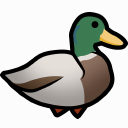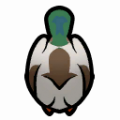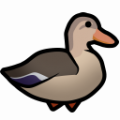Difference between revisions of "Duck"
(→Eggs: This sentence was missing a word.) |
Arcangelus (talk | contribs) (→Health: Changed to template version.) |
||
| Line 85: | Line 85: | ||
== Health == | == Health == | ||
| − | {{Animal Health Table}} | + | {{Animal Health Table|Bird}} |
== Gallery == | == Gallery == | ||
Latest revision as of 12:41, 1 July 2024
Duck
A very common type of farm bird, also appearing in the wild, the duck is raised for its delicious meat. It grows quick but lays eggs quite rarely.
Base Stats
- Type
- Animal
- Flammability
- 70%
Pawn Stats
- Combat Power
- 30
- Move Speed
- 2.1 c/s
- Health Scale
- 0.35
- Body Size
- 0.3
- Mass - Baby
- 1.8 kg
- Mass - Juvenile
- 9 kg
- Mass - Adult
- 18 kg
- Carrying Capacity
- 23 kg
- Filth Rate
- 4
- Hunger Rate
- 0.28 Nutrition/Day
- Diet
- herbivorous
- Life Expectancy
- 6 years
- Manhunter Chance
- 0%
- Manhunter Chance (Taming)
- 0%
- Trainable Intelligence
- None
- Wildness
- 0%
- Roam Interval
- 7 days
- Mate Interval
- 8 hours
- Maturity Age
- 0.2 years (12 days)
- Juvenile Age
- 0.12 years (7.2 days)
- Comfortable Temp Range
- -10 °C – 40 °C (14 °F – 104 °F)
Production
- Meat Yield
- 42 duck meat
- Eggs Per Clutch
- 1 to 1
- Egg Laying Interval
- 1 days
- Can Lay Unfertilized Eggs
- true
Melee Combat
- Attack 1
- Feet
3 dmg (Scratch)
4 % AP
1.5 second cooldown - Attack 2
- Beak
4 dmg (Bite)
6 % AP
2 second cooldown - Attack 3
- Head
2 dmg (Blunt)
3 % AP
1.5 second cooldown
0.2 chance factor - Average DPS
- 1.1
- tradeTags
- AnimalFarm, AnimalCommon
A small, domesticated waterfowl, Ducks, called ducklings as babies, are not found in the wild, and can only be purchased from traders or received in self-taming events. Like chickens, ducks mature quickly and lay eggs often, making them both good meal birds and sources of eggs. Males of the species can be distinguished by their green heads and two-tone body while females have a solid colour head and body with darker wings.
Summary[edit]
Ducks are pen animals. Once tamed, pen animals cannot and do not need to be trained any further. But if left outside of a pen or caravan hitching spot, pen animals will eventually roam outside your colony. Making a caravan is not required to tie animals to a caravan hitching spot.
A female duck produces 1 egg every 1 day. Ducks can lay both unfertilized and fertilized eggs, depending on if it has mated with a male.
Analysis[edit]
Ducks are the second best animal for egg production, and one of the best overall animals for meat production. Ducks reproduce rapidly.
Ducks are nearly identical to chickens, providing the same yields in both meat and eggs. However, ducks consume 20% more nutrition, meaning that chickens are better livestock. If chickens are not available but ducks are, then ducks can be a suitable replacement.
Eggs[edit]
An adult duck consumes 0.28 nutrition per day, and produces 0.25 nutrition of eggs each day. This results in a nutrition efficiency of 89.3% when unfertilized eggs are eaten. Overeating, and the existence of males, will lower nutrition efficiency in practice.
Note that slaughtering ducklings gives more nutrition than eating unhatched eggs (0.6 from meat rather than 0.25 from 1 egg). However, a handler has to actually slaughter each duck, and a butcher's yields are multiplied by Butchery Efficiency. So if you don't have a skilled cook, eggs may be better for nutrition. Also, eggs are vegetarian.
Meat[edit]
When slaughtered, a duck yields 12 meat as a duckling; 26 as a juvenile; or 42 as an adult. No leather is yielded.
When ducklings are slaughtered, an always-fertilized female duck produces 0.6 nutrition per day, resulting in a nutrition efficiency of 214.3% when not considering males, or 142.9% when accounting for the 2:1 female:male ratio needed to achieve a good fertilization rate.
As a duck grows into adulthood, it will consume 1.81 nutrition in total, and will yield 1.5 more nutrition when slaughtered than it would as a baby. Therefore, it is better to slaughter ducks as soon as they hatch from an egg.
When slaughtered as ducklings, ducks are better than almost all animals in terms of theoretical meat : food consumption ratio, below chickens and tortoises. This efficiency is lower than it seems, as ducks are prone to overeating. Due to the amount of slaughtering required with ducks, players may prefer to ranch horses or ibex instead.
Feeding[edit]
A duck consumes 0.28 nutrition per day, or roughly 6 hay.
The following is a list of how many tiles of haygrass it takes to sustain a mature duck.
- Gravel: 5.25
- Soil: 4.31
- Rich Soil: 3.47
Training[edit]
This animal can be trained as follows:
| Guard: | |
|---|---|
| Attack: | |
| Rescue: | |
| Haul: | |
*As of version 1.1.2610, all animals can be tamed. The percentage of likelihood of success depends on factors such as the Animals Wildness Percentage, Pawn Handling Skill, and others. More information can be found on the animals page.
Health[edit]
| Part Name | Health | Quantity | Coverage[1] | Target Chance[2] | Subpart of | Internal | Capacity[3] | Effect if Destroyed/Removed |
|---|---|---|---|---|---|---|---|---|
| Body | 14 | 1 | 100% | 19% | N/A[4] | - | Death | |
| Tail | 3.5 | 1 | 10% | 10% | Body | - | - | |
| Spine | 8.75 | 1 | 5% | 5% | Body | Moving |
−100% Moving[5] | |
| Stomach | 7 | 1 | 4% | 4% | Body | Digestion |
−50% Digestion | |
| Heart | 5.25 | 1 | 3% | 3% | Body | Blood Pumping |
Death | |
| Lung | 5.25 | 2 | 4% | 4% | Body | Breathing |
−50% Breathing. Death if both lost | |
| Kidney | 5.25 | 2 | 3% | 3% | Body | Blood Filtration | −50% Blood Filtration. Death if both lost | |
| Liver | 7 | 1 | 5% | 5% | Body | Digestion |
−50% Digestion | |
| Neck | 8.75 | 1 | 20% | 5% | Body | Eating Talking Breathing |
Death | |
| Head | 8.75 | 1 | 75% | 3.1% | Neck | - | Death | |
| Skull | 8.75 | 1 | 30% | 1.8% | Head | - | Cannot be destroyed Increasing Pain based on damage. | |
| Brain | 3.5 | 1 | 60% | 2.7% | Skull | Consciousness |
Death Damage always results in scarring. | |
| Eye | 3.5 | 2 | 12% | 1.8% | Head | Sight |
−25% Sight. −100% if both lost. Damage always results in scarring. 0% Hit Chance against Blunt damage. | |
| Beak | 7 | 1 | 25% | 3.8% | Head | Eating Talking Manipulation |
−100% Manipulation −90% Eating[6] | |
| Leg | 10.5 | 2 | 10% | 5% | Body | Moving |
−50% Moving. −100% if both lost | |
| Foot | 8.75 | 2 | 50% | 5% | Leg | Moving |
−50% Moving. −100% if both lost |
- ↑ Coverage determines the chance to hit this body part. It refers to the percentage of the super-part that this part covers, before its own sub-parts claim their own percentage. For example, if the base coverage of the super-part is 100%, and the coverage of the part is 20%, 20% of hits would hit the part, and 80% the super-part. If the part had its own sub-part with 50% coverage, the chances would be 10% sub-part, 10% part, 80% super part.
- ↑ Target Chance is the actual chance for each part to be be selected as the target when each part's coverage has been taken into account(I.E. Neck covers 7.5% of Torso but Head covers 80% of Neck so it actually has only a 1.5% chance to be selected). This is not pure hit chance, as different damage types propagate damage in different ways. See that page for details.
- ↑ Note that capacities can affect other capacities in turn. Only the primary effect is listed. See specific pages for details.
- ↑ This is the part that everything else connects to to be considered 'connected'.
- ↑ If Moving drops below 16% a pawn cannot move.
- ↑ Note that eating won't go below 10%. See specific pages for details.
Gallery[edit]
Version history[edit]
- 1.1.0 - Added as part of the integration of the Vanilla Animals Expanded - Livestock mod into the base game.
- 1.3.3066 - Adjusted to be more similar to chicken as a part of a large livestock rebalance







